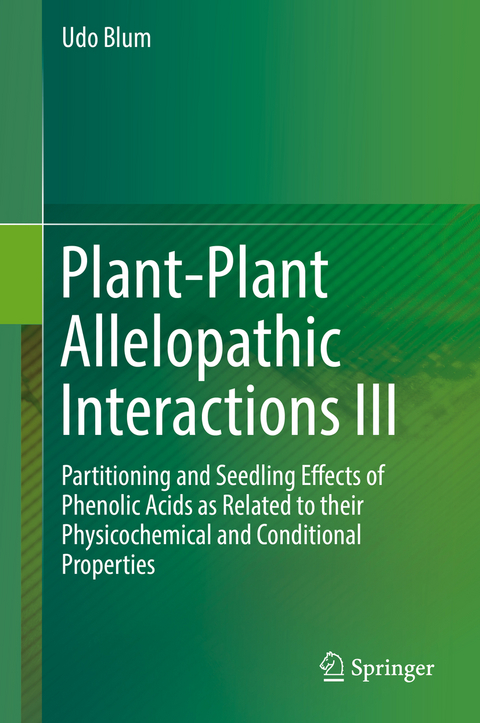
Plant-Plant Allelopathic Interactions III
Springer International Publishing (Verlag)
978-3-030-22097-6 (ISBN)
This volume continues the retrospective analyses of Volumes I and II, but goes beyond that in an attempt to understand how phenolic acids are partitioned in seedling-solution and seedling-microbe-soil-sand culture systems and how phenolic acid effects on seedlings may be related to the actual and/or conditional physicochemical properties (e.g., solubility, hydrophobicity, pKa, molecular structure and soil sorption/desorption) of simple phenolic acids. Specifically, it explores the quantitative partitioning (i.e., source-sink relationships) of benzoic and cinnamic acids in cucumber seedling-solution and cucumber seedling-microbe-soil-sand systems and how that partitioning may influence phenolic acid effects on cucumber seedlings. Regressions, correlations and conceptual and hypothetical models are used to achieve these objectives. Cucumber seedlings are used as a surrogate for phenolic acid sensitive herbaceous dicotyledonous weed seedlings. This volumewas written specifically for researchers and their students interested in understanding how a range of simple phenolic acids and potentially other putative allelopathic compounds released from living plants and their litter and residues may modify soil chemistry, soil and rhizosphere microbial biology, seedling physiology and seedling growth. In addition, this volume describes the potential relationships, where they may exist, for direct transfer of organic compounds between plants, plant communication and plant-plant allelopathic interactions and addresses the following questions: Can physicochemical properties of phenolic acids be used as tools to help understand the complex behavior of phenolic acids and the ultimate effects of phenolic acids on sensitive seedlings? What insights do laboratory bioassays and the conceptual and hypothetical models of laboratory systems provide us concerning the potential behavior and effects of phenolic acids in field systems? Whatpotential role may phenolic acids play in broadleaf-weed seedling emergence in wheat debris cover crop no-till systems?
Professor Emeritus at NC State University, Prof. Udo Blum is interested in characterizing and identifying the mechanisms by which allelopathic compounds, specifically phenolic acids (e.g., ferulic acid, p-coumaric acid, vanillic acid, p-hydroxybenzoic acid), released into the soil environment may impact soil chemistry (e.g., soil nutrition, organic pools, sorption and desorption), soil microbiology (e.g., population biology, natural selection, carbon utilization), rhizosphere ecology (e.g., microbial population biology) and population biology (e.g., germination, seedling emergence) and physiology (e.g., mineral nutrition, carbon allocation, water relations, growth) of dicot weeds in no-till agroecosystems.
Chapter 1. Reflections Regarding Plant-Plant Interactions, Plant-Plant Communications and Plant-Plant Allelopathic Interactions with an Emphasis on Plant-Plant Allelopathic Interactions.- Chapter 2. General Background for Plant-Plant Allelopathic Interactions.- Chapter 3. Conceptual Models for Soil Systems and Physicochemical Properties of Organic Compounds.- Chapter 4. Simple Phenolic Acids in Solution Culture I: pH and pKa.- Chapter 5. Simple Phenolic Acids in Solution Culture II: Log P, Log D and Molecular structure.- Chapter 6. Simple Phenolic Acids in Soil Culture I: Sorption, Kd and KOC.- Chapter 7. Simple Phenolic Acids in Soil Culture II: Biological Processes in Soil.- Chapter 8. Hypothetical Solution-Culture System Sub-Models.- Chapter 9. Hypothetical Soil-Culture System Sub-Models.- Chapter 10. Quantitative Hypothetical System Models for Cecil Soil-Sand Systems.- Chapter 11. Quantitative Hypothetical System Model for Portsmouth Soil-Sand System and Potential Modifying Factors.- Chapter 12. Epilog: Assumptions, Models, Hypotheses and Conclusions.
| Erscheinungsdatum | 01.09.2019 |
|---|---|
| Zusatzinfo | XLIX, 503 p. 70 illus. |
| Verlagsort | Cham |
| Sprache | englisch |
| Maße | 155 x 235 mm |
| Gewicht | 991 g |
| Themenwelt | Naturwissenschaften ► Biologie ► Botanik |
| Schlagworte | Allelopathic interactions • Biossays • ecotoxicology • Phenolic acids • Physicochemical properties • Plant-Plant Interactions • Soil Cultures • systems biology |
| ISBN-10 | 3-030-22097-4 / 3030220974 |
| ISBN-13 | 978-3-030-22097-6 / 9783030220976 |
| Zustand | Neuware |
| Haben Sie eine Frage zum Produkt? |
aus dem Bereich


